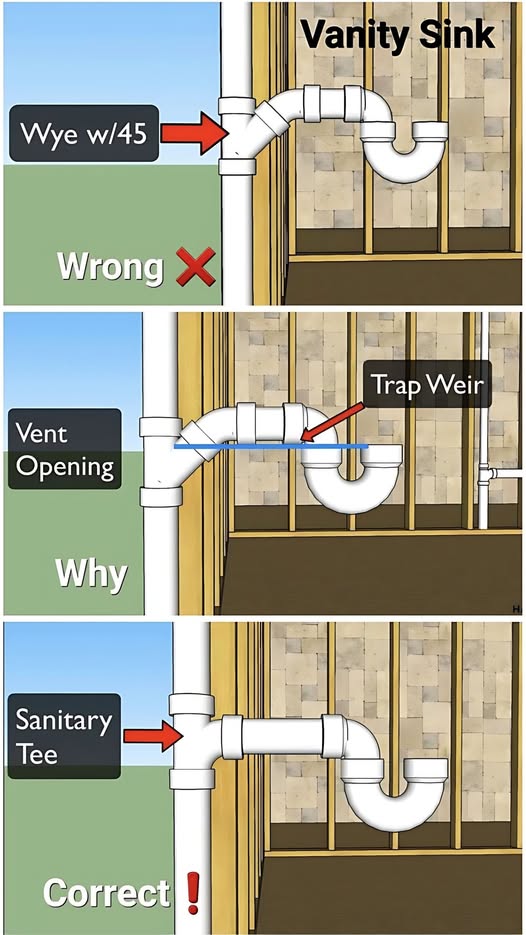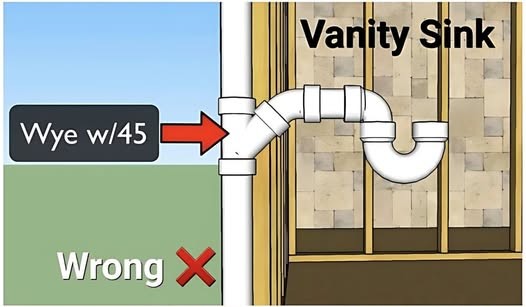This image illustrates the correct and incorrect methods for venting a vanity sink drainpipe. It highlights why one method is wrong and the other is correct based on plumbing principles.
Top Image: Incorrect Venting (Wye with 45°)
- Description: The top image shows a drain line from a vanity sink connected to a vertical drain stack using a wye fitting oriented at a 45-degree angle. The vent pipe is connected to the branch of this wye.
- Label: This configuration is labeled “Wrong” with a red “X”.
- Issue: This method is incorrect because the vent opening is positioned too low relative to the trap weir. Wastewater draining from the sink can easily flow into and obstruct the vent pipe. This blockage prevents proper airflow, which is essential for maintaining atmospheric pressure in the drain system and preventing the trap seal from being siphoned.
Middle Image: Explanation of Why it’s Wrong

- Description: This image zooms in on the incorrect connection. A blue horizontal line labeled “Trap Weir” indicates the highest point of the water level in the P-trap. The vent opening is shown to be below this level.
- Label: This section is labeled “Why“.
- Reason: The explanation visually demonstrates that the “Vent Opening” is situated such that it can be submerged by wastewater backing up in the drain line or splashing during normal drainage. When the vent is blocked by water or debris, it cannot perform its function of allowing air into the system.
Bottom Image: Correct Venting (Sanitary Tee)
- Description: The bottom image shows the drain line from the vanity sink connected to the vertical drain stack using a sanitary tee. The vent pipe is connected to the upward-facing branch of the sanitary tee, positioned vertically above the drain line.
- Label: This configuration is labeled “Correct” with a red exclamation mark “!”.
- Reason: Using a sanitary tee ensures that the vent opening is located above the flood level rim of the fixture and, more importantly, well above the trap weir. This prevents wastewater from entering and blocking the vent pipe, allowing for proper ventilation of the drain system. The vertical rise before the vent line turns horizontal (if applicable) is crucial to keep the vent clear.
Key Plumbing Principles Illustrated:
- Proper Venting: Plumbing vents are essential for allowing air to enter the drain system. This prevents negative pressure (suction) that can siphon water out of the P-traps, which are designed to block sewer gases from entering the building.
- Trap Weir Protection: The vent opening must be positioned in a way that prevents it from being blocked by wastewater, ensuring the integrity of the trap seal.
- Sanitary Fittings: Sanitary tees are specifically designed for drain-waste-vent (DWV) systems to facilitate the proper separation of drainage and venting. Wye fittings, especially when oriented incorrectly, can lead to vent blockage.
In summary, the image clearly demonstrates the importance of using a sanitary tee for venting a fixture drain to ensure proper airflow and prevent vent blockage, thereby maintaining a functional and safe plumbing system.



